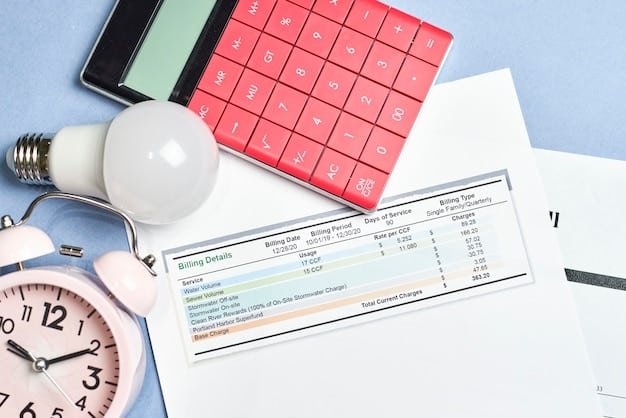Prioritize Your Debts: Step-by-Step Guide to Financial Freedom

Prioritizing your debts effectively involves assessing interest rates, differentiating between secured and unsecured debts, and creating a strategic repayment plan to achieve financial stability and reduce overall financial stress.
Are you feeling overwhelmed by the weight of multiple debts? Learning how to prioritize your debts: a step-by-step guide to financial stability is crucial for regaining control of your finances and paving the way towards a debt-free future.
Understanding the Importance of Debt Prioritization
Debt can feel like a never-ending cycle, but understanding its nature and how to prioritize it is the first step toward financial freedom. Effective debt management isn’t just about making payments; it’s about strategically allocating your resources to minimize long-term costs and stress.
Prioritizing your debts allows you to tackle the most pressing financial burdens first, potentially saving you money on interest and fees. It also provides a structured approach to debt repayment, making the process more manageable and reducing the feeling of being overwhelmed.
Step 1: List All Your Debts
Before you can prioritize, you need a clear overview of everything you owe. Gathering all the necessary information in one place is a great place to start!
Create a Comprehensive Debt Inventory
Start by creating a detailed list of all your outstanding debts. This list should include:
- Name of the creditor (e.g., credit card company, lender)
- Type of debt (e.g., credit card debt, student loan, mortgage)
- Outstanding balance
- Interest rate
- Minimum monthly payment
Organize this information in a spreadsheet or document for easy reference. Having a clear picture of your debt obligations is crucial for the next steps.
This comprehensive overview sets the stage for effective prioritization. Knowing exactly what you owe, to whom, and at what cost is the foundation for smart financial decisions.

Step 2: Identify High-Interest Debts
High-interest debts are often the most financially damaging, as they accumulate costs rapidly. Focusing on these debts first can save you a significant amount of money in the long run.
Why High-Interest Debts Should Be Prioritized
Debts with higher interest rates cost you more over time. By paying them off first, you reduce the total amount you’ll pay in interest charges, freeing up more money for other financial goals.
- Credit card debt often carries the highest interest rates.
- Payday loans are another example of high-interest debt due to their structure.
- Personal loans can have high interest rates, depending on your credit score.
This simple yet effective strategy can have a significant impact on your financial well-being. It allows you to allocate your resources where they make the most difference.
Step 3: Assess Secured vs. Unsecured Debts
Understanding the difference between secured and unsecured debts is important for managing risk and prioritizing repayment. Secured debts are often tied to specific assets that can be repossessed if you default.
Secured debts are backed by collateral, such as a house (mortgage) or a car (auto loan). Unsecured debts, like credit card debt and personal loans, are not backed by specific assets. Failing to pay secured debts can lead to asset repossession so it’s important to keep that in mind.
Examples of Secured and Unsecured Debts
- Secured Debt: Mortgages and Auto loans are the most common types of secured debt.
- Unsecured Debt: Credit Cards, Medical Bills, and Student Loans (in some instances) fall into this category.
By understanding the nature of your debts, you can make informed decisions about which ones to prioritize and how to manage the risks associated with each.
Step 4: Choose a Debt Prioritization Method
Two popular methods for prioritizing debts are the debt avalanche and the debt snowball. Each method has its own advantages and can be effective depending on your financial situation and personal preferences.
Debt Avalanche vs. Debt Snowball
The debt avalanche method focuses on paying off debts with the highest interest rates first, regardless of the balance. This approach saves you the most money in the long run.
The debt snowball method prioritizes paying off debts with the smallest balances first, regardless of the interest rate. This approach provides quick wins and can boost your motivation.

Choosing the right method depends on your individual needs and preferences. Consider your financial goals and psychological factors to make the best decision for your situation.
Step 5: Create a Budget and Stick to It
A well-structured budget is essential for effective debt management. It helps you track your income and expenses, identify areas where you can save money, and allocate funds for debt repayment.
Setting Up Your Budget
Begin by listing all your sources of income and your regular expenses. Determine where you spend your money and cut out on unnecessary or low cost items.
- Track Your Spending: Use budgeting apps or spreadsheets to track your expenses.
- Allocate Funds: Set aside a specific amount for debt repayment each month.
- Adjust as Needed: Review and adjust your budget regularly to adapt to changing circumstances.
A well-maintained budget is a powerful tool for controlling your finances and making progress towards your debt repayment goals.
Step 6: Negotiate with Creditors
Don’t hesitate to contact your creditors and negotiate lower interest rates or payment plans. Many creditors are willing to work with you, especially if you’re facing financial hardship.
Strategies for Negotiating
Prepare your financial information and be honest about your situation. Ask for lower interest rates, waived fees, or a payment plan that fits your budget.
- Contact Creditors: Reach out to your creditors and explain your situation.
- Ask for Help: Inquire about hardship programs or debt management plans.
- Document Everything: Keep records of all communications and agreements.
Negotiating with creditors can be a valuable strategy for reducing your debt burden and making repayment more manageable.
| Key Point | Brief Description |
|---|---|
| 📝 List All Debts | Create a comprehensive list of all outstanding debts. |
| 💰 High-Interest First | Focus on paying off debts with the highest interest rates. |
| 🛡️ Secured vs. Unsecured | Understand the difference for risk management. |
| 🤝 Negotiate | Contact creditors to negotiate better terms. |
Frequently Asked Questions
Prioritizing debts allows you to minimize interest costs, manage risk, and create a clear repayment strategy, ultimately leading to financial stability and reduced stress.
The debt avalanche method focuses on paying off debts with the highest interest rates first, which saves you the most money on interest over time.
The debt snowball method prioritizes paying off debts with the smallest balances first, providing quick wins that can boost your motivation.
Contact your creditors, explain your situation, and ask for lower interest rates, waived fees, or more manageable payment plans. Many creditors are willing to help.
Budgeting helps you track income and expenses, identify savings opportunities, and allocate funds specifically for debt repayment, ensuring consistent progress.
Conclusion
By following this step-by-step guide, you can effectively prioritize your debts, regain control of your finances, and work towards a brighter, debt-free future. Remember, consistency and discipline are key to achieving your financial goals.





